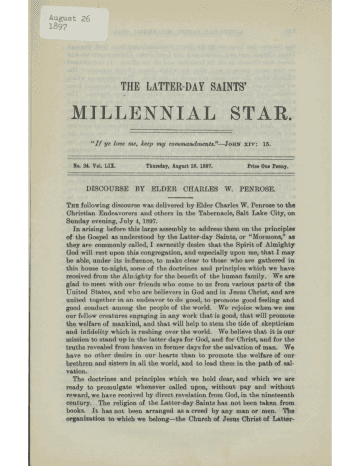Magazine
The Urim and Thummim

Title
The Urim and Thummim
Magazine
The Latter Day Saints' Millennial Star
Publication Type
Magazine Article
Year of Publication
1897
Authors
Parry, E.F. (Primary)
Pagination
540–541
Date Published
26 August 1897
Volume
59
Issue Number
34
Abstract
Parry argues that Joseph Smith’s description of the Urim and Thummim coincide with the Bible’s description. Since this and other statements of Joseph Smith coincide with the Bible, Joseph Smith was divinely inspired.
THE URIM AND THUMMIM.
In the account which the Prophet Joseph Smith gives of the coming forth of the Book of Mormon, he says that an angel directed him to a certain hill in the side of which was buried a stone box. In this box he found the plates containing the writings from which the Book of Mormon was translated. With these plates other things were buried, and among them were what he describes as two stones set in silver bows, and fastened to a breastplate. These instruments he calls the Urim and Thummim. They are similarly described in the Book of Mormon, in which they are called interpreters. In translating the ancient record engraven upon the gold plates the Prophet used these interpreters. By the power of the Lord he was enabled to look upon these stones and read the English translation of the ancient writings as it appeared upon them sentence by sentence.
Many unbelievers, who read the account of this remarkable method of translating, not only refuse to believe it, but ridicule the idea of using such instruments for such a purpose. It certainly would be absurd for an uninspired man to take two ordinary stones from the earth and with their aid attempt to translate a record written in an unknown language. But the stones of the Urim and Thummim were prepared by the Lord for certain sacred purposes, and it was through a gift from Him that the record contained in the Book of Mormon was translated.
Those who scoff at the means employed by the modern Prophet in this work show their ignorance of the Bible, and of the methods the Lord made use of in ancient times to reveal intelligence to His chosen servants.
The 30th verse of the 28th chapter of Exodus mentions the existence of these sacred instruments in the days of Moses: “And thou shalt put in the breastplate of judgment the Urim and the Thummim; and they shall be upon Aaron’s heart, when he goeth in before the Lord: and Aaron shall bear the judgment of the children of Israel upon his heart before the Lord continually.” Again they are mentioned as being connected with a breastplate in the 8th verse of the 8th chapter of Leviticus.
That these instruments were used anciently for the purpose of getting information from a divine source is evident from Numbers 27:21, and from the following passage found in the 6th verse of the 28th chapter of First Samuel: “And when Saul enquired of the Lord, the Lord answered him not, neither by dream, nor by Urim, nor by prophets.” At a later date, in the 63rd verse of the 2nd chapter of Ezra, and in the 66th verse of the 7th chapter of Nehemiah, the Urim and Thummim are mentioned in such a way as to imply that they were used by the priests to receive enlightenment from the Lord.
The “Helps to the Study of the Bible,” contained in the Oxford Teachers’ Bible, under the heading of “A Glossary of Antiquities, Customs, etc.,” furnishes some explanation of the use of the Urim and Thummim. Their meaning is given as “Lights and Perfections;” and they are described as “the sacred symbols (worn upon the breastplate of the high priest ‘upon his heart’), by which God gave oracular responses for the guidance of His people in temporal matters.” It is further stated that “What they were is unknown; they are introduced in Exodus without explanation, as if familiar to the Israelites of that day. * * * Some scholars suppose that they were the twelve stones of the breastplate; others that they were two additional stones concealed in its fold. Josephus adds to these the two sardonyx buttons worn on the shoulders, which, he says, emitted the luminous rays when the response was favorable; but the means by which the oracles were given is lost in obscurity.”
The description of the Urim and Thummim and of their purposes given by the Prophet Joseph is not in the least at variance with what is said of them in the Bible, or with what the world knows of them. This simple fact, when considered in connection with others, goes to prove that he was inspired, and that he was actually in possession of these instruments, or his attempt to describe them and to explain their use would have been faulty; for it is not at all likely that he got his description of them from the Bible or from other published works of his day. If he did take the pains to make the necessary research in order to give a description of them that would harmonize with what was known about them, this one fact of itself, of course, would furnish no evidence of his being divinely assisted. But his extensive writings and translation contain so many hundreds of statements in his writings fully agree with facts discovered subsequent to the time of his recording them, and he had no opportunity to compare and harmonize these, before announcing them to the world, consequently the only way to account for the accuracy of his writings is to admit that he was divinely inspired. E.F.P.
Subject Keywords
Bibliographic Citation
Terms of use
Items in the BMC Archive are made publicly available for non-commercial, private use. Inclusion within the BMC Archive does not imply endorsement. Items do not represent the official views of The Church of Jesus Christ of Latter-day Saints or of Book of Mormon Central.